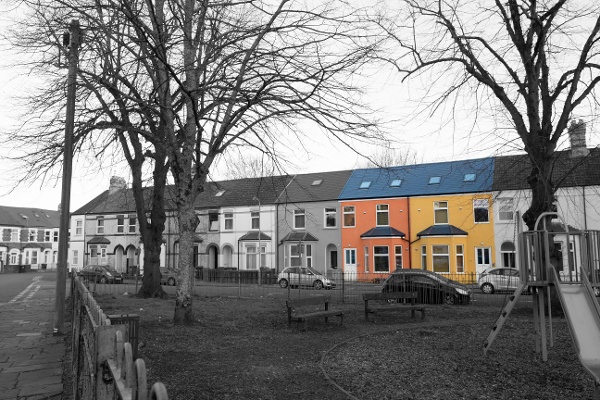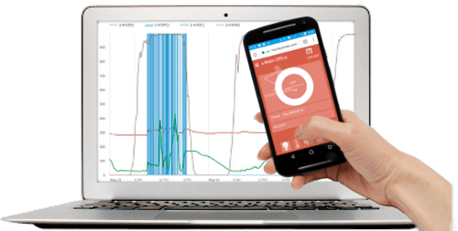
Our Senior Data Scientist, Dr Kat Kelly recently showed that rented flats using variable ventilation and direct electrical heating under Atamate smart control delivered...
The UK government has published a consultation document for its Future Homes policy, which is intended to update the building regulations covering energy efficiency (Part L) and ventilation (Part F) by 2025. Atamate welcomes the aim to cut the energy needs of British housing stock and particularly the preferred approach which prioritises carbon-saving technology, but our view is that the potential of smart building technology is not recognised.
This article is part of a series detailing Atamate's response to the Future Homes consultation. The others are:
Future Homes 1: Atamate calls for an outcome-based approach
Future Homes 3. Heat Pumps - are they the solution we’ve been looking for?
Future Homes 4: Future-proofing against overheating

In our previous article, we welcomed the intentions that the Ministry of Housing, Communities and Local Government (MHCLG) express in the Future Homes consultation document, and particularly their preference for an approach based around carbon-saving technology. We also expressed our reservations about their emphasis on particular technologies, which risks excluding others that may have a significant role to play.
Atamate’s core product is a building control system that’s suitable for the domestic market, so it’ll surprise no one to know that we’re particularly concerned that the Future Homes consultation doesn’t recognise the role that smart building controls can play in achieving their stated goals.
Our recent case study of rented flats that were fitted with Atamate’s smart building controls, which make a building smart by integrating all of its services under a single control system, demonstrated that a smart building is capable of meeting very high standards of energy efficiency using existing technology.
Atamate comfortably met the heating energy target of 15kwh/m2/yr recommended in the CCC's UK Housing: Fit for the Future report which was referred to repeatedly in the Future Homes consultation paper. The CCC's own view, expressed in their response to the Future Homes consultation, was that 15kwh/m2/yr is a target that could be achieved by 2025 which is disappointing given that we have already achieved it.
Our case study also shows MHCLG's characterisation of building control systems to be outdated:
Such systems would typically be installed in large commercial buildings but not usually in dwellings. However, it’s possible that a building automation and control system could be installed in a large apartment block.
- Section 3.73
We beg to differ; we’ve installed Atamate in a number of homes ranging from houses occupied by families to the single-occupant flats in our case study.
MHCLG's description appears to be based on the type of building management systems used in buildings large enough to warrant a full-time management staff. Such systems are not suitable for domestic uses, but a system like Atamate is in a different category. It has much lower installation costs, doesn’t require specialised training for the installer, and only requires minimal input once installed so can be operated by a homeowner.
The heating devices used in our case study were panel and infrared heaters powered by mains electricity, which were far less expensive to obtain and install than the heat pumps that MHCLG anticipates as playing a major role in the future.
A further argument in favour of heating powered by mains electricity comes from the Committee for Climate Change (CCC)’s 2018 progress report on cuts to UK carbon emissions, which stated that 75% of reductions since 2012 had come from the power sector and that carbon emissions from power generation continue to fall. Therefore, reduction in carbon emissions is being achieved by adopting renewable sources of energy rather than by cutting demand for energy.
Based on that finding, the best way of achieving low-carbon heating is likely to be by using devices powered by mains electricity with minimal carbon emissions during manufacture and installation.
The omission of smart building controls is particularly striking in the light of MHCLG's proposal to mandate zonal control of heating using self-regulating devices:
This means including devices for the separate regulation of the temperature in each room or designated heating zone (where this is justified) of the building. A common way of achieving this in practice for new homes would be having thermostatic radiator valves (TRVs) on radiators in each room.
- Section 3.71
We agree that zonal control is key to maximising both comfort and energy efficiency, and indeed it’s one of the principles that underlie Atamate building controls. It replaces the traditional system of using a single thermostat in one location to regulate heating throughout a building, which leads to many rooms never actually reaching the chosen temperature while wasting energy heating rooms that are already comfortable.
Thermostatic radiator valves may go some way to improving comfort and efficiency in older buildings, but we don’t see them as the best solution for well-insulated buildings in which overheating is likely to be a significant problem.
In addition, the wording incorrectly implies that placing a thermostat on a heating device is synonymous with zonal control. True zonal control requires a single system that monitors the environment in each designated zone and selects the combination of services that regulates it in the most efficient way.
A thermostat controlling a single heating device can only react to the room temperature by switching the heater on or off. If the room stays cold because a window has been left open, the thermostat will simply keep the device on even though the room is not getting any warmer.
A building control system would recognise that the window was open and switch off the heater. In a fully automated building, the windows would be motorised so it would close them if the room was too cold. The controls would also have access to a range of ways to regulate the temperature of the room, such as by opening or closing a blind to regulate solar gains.
We‘ve been installing and supporting such control systems for several years. The technology is mature and is already delivering MHCLG's stated energy efficiency goals.
A building control system applies zonal control to internal air quality as well as heating, which offers an opportunity that MHCLG doesn’t grasp. They propose to simplify the requirements of the building regulations that cover ventilation (Part F) by removing the consideration based on the number of occupants and mandating an airflow of 6l/s per bedroom in the home (section 4.27).
Our view is that as the role of ventilation is to maintain air quality, the ventilation regulations should be based on air quality. To base regulations around airflow would be to prioritise the means over the end.
Read all about Atamate’s smart ventilation control and the benefits it brings.
There’s an argument for mandating that a building's ventilation system should be able to achieve a minimum airflow rate which may be 6l/s, but it doesn’t follow that it needs to run at full capacity all of the time. Doing so would vent air that was of a perfectly acceptable quality out of the building and require the heating system to heat air being drawn into the building unnecessarily.
The only measurement of air quality proposed is based on volatile organic compounds (VOCs) (section 4.9), which are released by paints and plastics. We acknowledge that VOCs can be significant polluters of the indoor environment. They can irritate the nose and throat if they reach high enough concentrations and can exacerbate the effects of allergies and asthma.
However, we don’t agree that VOC concentrations are the most important indicator of indoor air quality for two reasons: firstly, if a room is so poorly ventilated that VOCs rise to levels where they become a threat to health, anyone in that room should be more worried about the carbon dioxide they’re breathing out than the VOCs. As we breathe, we add a litre of carbon dioxide to the air around us every few minutes, so it doesn’t take long for carbon dioxide levels in an unventilated room to rise from the background of 400-500 parts per million to the 1,500 parts per million at which measurable cognitive impairment occurs.
The second reason is that VOCs are difficult to measure accurately, largely because there are several thousand different types of VOC. Sensors like Atamate's generate an index based on the total concentration of VOCs in the air. They don’t give the precise measurements that would be needed to compare to a threshold at which the ventilation system needs to be engaged.
MHCLG suggest using an array of sensors to detect different types of VOC (section 4.10), although they don’t specify how many different types should be measured so it’s not clear how expensive the array would be or how much value it would add when compared to a single VOC sensor. Each sensor would still be recording an index based on a class of VOC rather than returning a precise measurement of a given compound.
However specific the VOC measurements are, a standalone sensor is no more than a recording device that can indicate whether air quality standards are being met. It can only influence air quality standards if it’s part of a building control system that uses the ventilation system to react to the VOC measurements.
Atamate regulates ventilation based on an air quality index derived from a multiparameter sensor unit measuring carbon dioxide, humidity, VOCs, and air temperature. When any of the parameters fall below acceptable levels, the ventilation system is engaged. The multiparameter sensor is as easy to install as a single VOC sensor and gives much more comprehensive information on air quality, as well as being cheaper than a sensor array that would give information on different types of VOC. Because the sensor data is processed by a central hub, it could incorporate data from other sensors if they were necessary for a given installation, such as the carbon monoxide sensors needed in a building connected to the gas main.
A ventilation system is tailored to the needs of the individual building, though the broad principle is to draw air into rooms that typically have good air quality, pass it through the building to rooms which have the poorest air quality, and then expel it from the building.
In our case study, an extractor fan expels air from the kitchens and bathrooms, where cooking and showering tends to cause high levels of humidity and smells. When the fan engages, the air is drawn in through vents in the bedrooms and living rooms. When the air quality rises to the pre-determined threshold, the inlet vents are closed with damper valves to preserve the insulation.
For example, several people gathering in the living room may cause a buildup of carbon dioxide. The system will respond to this by activating the extractor fan and opening vents in the living room, maintaining air quality without drawing heated air from a bedroom that may be occupied but already has good air quality.
In this example, Atamate is controlling ventilation across several zones while preserving the airtightness of others to limit heating costs, which is only possible when heating and ventilation are both automated and under the control of a single system.
In their response to the Future Homes consultation, the CCC recommends a fundamental change in the way that compliance and performance are monitored:
Driving a shift towards monitoring actual energy consumption so that by the time the Future Homes standard is introduced, it can be done on an in-use energy performance basis.
Their recommendation can be fulfilled by a function of a building control system that’s not considered at all in the Future Homes document: it collects data on energy usage. It was by using data collected during the routine operation of the Atamate control system that we were able to show we met the CCC's target of 15kwh/m2/yr for heating energy consumption.
The current system for assessing a building's energy usage is based around the Standard assessment procedure (SAP), which models expected energy usage based on the design. Future Homes proposes updating the SAP but doesn’t propose any form of post-occupancy evaluation to establish whether the predictions based on the SAP energy model were accurate.
Where post-occupancy evaluations have been carried out, energy consumption often turns out to be substantially more than predicted by the SAP energy model, a deficit commonly described as the 'performance gap'. Pieter de Wilde of Plymouth University identified the failure of SAP models to accurately predict climate variation and occupant behaviour as the main reasons for the performance gap.
As novel technologies become more widely used in our homes, a post-occupancy evaluation will become more important to test whether the occupants are using those technologies in the most efficient way. That process is already recognised by the Soft Landings Framework offered by BSRIA Ltd, which uses post-occupancy monitoring to help occupants get the best performance out of new buildings. However, a consultation process like Soft Landings may offer significant savings to large buildings such as office blocks and university departments but isn’t affordable to most homeowners.
A smart building control system can help the homeowner optimise their building services in two different ways: by alerts and by reporting.
Alerts warn the homeowner if an anomaly indicates a need for maintenance. For example, a fall in water pressure or a buildup of humidity in an unexpected place may indicate a leak in a water pipe that has not been noticed, which will put more strain on the water pump. Repairing the leak cuts the power needed by the pump as well as avoiding water damage.
Reporting is made possible by the storage of all sensor and usage data, which can be reviewed to see if a change in settings may improve efficiency. For most homeowners, reports are likely to be most useful when a new device is added, or if an onsite generation system like solar-thermal panels is installed.
The manager or landlord of a multiple-occupancy building, such as a large house split into flats, is likely to have more flexibility to use the data to optimise device usage or to identify where installing a new device may be worthwhile.
From a policy perspective, collecting post-occupancy data from many buildings of different types would enable the energy model used for SAP to be made more accurate, and also to assess whether the policy targets of cutting energy have been met.
The next post in this series is:
Future Homes 3. Heat Pumps - are they the solution we’ve been looking for?
If you’d like to know more about our views on the future of housing in Britain, please ask us on this form and we'll be happy to let you know.

Our Senior Data Scientist, Dr Kat Kelly recently showed that rented flats using variable ventilation and direct electrical heating under Atamate smart control delivered...

The atBOS sensor network comprehensively monitors a building’s indoor environment and energy use. The data facilitates building management and can also be used in...